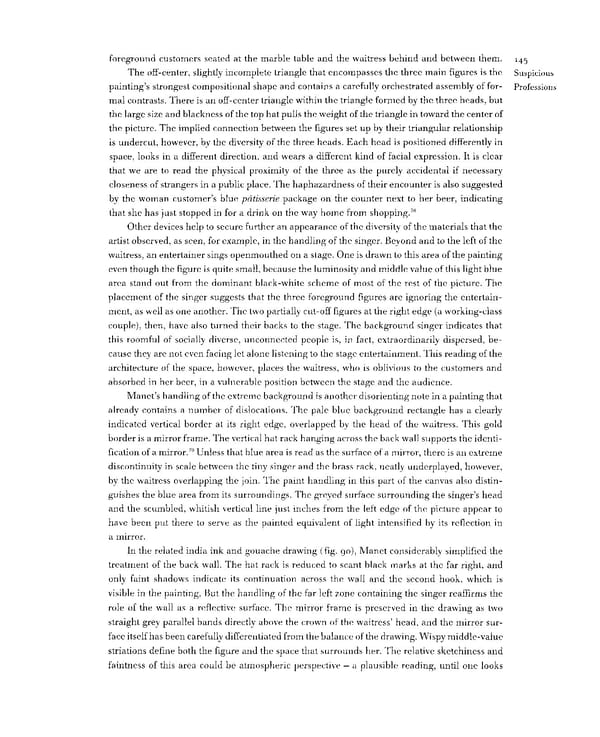foreground customers seated at the marble table and the waitress behind and between them. H5 The off-center, slightly incomplete triangle that encompasses the three main figures is the Suspicious painting's strongest compositional shape and contains a carefully orchestrated assembly of for- Professions mal contrasts. There is an off-center triangle within the triangle formed by the three heads, but the large size and blackness of the top hat pulls the weight of the triangle in toward the center of the picture. The implied connection between the figures set up by their triangular relationship is undercut, however, by the diversity of the three heads. Each head is positioned differently in space, looks in a different direction, and wears a different kind of facial expression. It is clear that we are to read the physical proximity of the three as the purely accidental if necessary closeness of strangers in a public place. The haphazardness of their encounter is also suggested by the woman customer's blue patisserie package on the counter next to her beer, indicating that she has just stopped in for a drink on the way home from shopping.78 Other devices help to secure further an appearance of the diversity of the materials that the artist observed, as seen, for example, in the handling of the singer. Beyond and to the left of the waitress, an entertainer sings openmouthed on a stage. One is drawn to this area of the painting even though the figure is quite small, because the luminosity and middle value of this light blue area stand out from the dominant black-white scheme of most of the rest of the picture. The placement of the singer suggests that the three foreground figures are ignoring the entertain- ment, as well as one another. The two partially cut-off figures at the right edge (a working-class couple), then, have also turned their backs to the stage. The background singer indicates that this roomful of socially diverse, unconnected people is, in fact, extraordinarily dispersed, be- cause they are not even facing let alone listening to the stage entertainment. This reading of the architecture of the space, however, places the waitress, who is oblivious to the customers and absorbed in her beer, in a vulnerable position between the stage and the audience. Manet's handling of the extreme background is another disorienting note in a painting that already contains a number of dislocations. The pale blue background rectangle has a clearly indicated vertical border at its right edge, overlapped by the head of the waitress. This gold border is a mirror frame. The vertical hat rack hanging across the back wall supports the identi- 79 fication of a mirror. Unless that blue area is read as the surface of a mirror, there is an extreme discontinuity in scale between the tiny singer and the brass rack, neatly underplayed, however, by the waitress overlapping the join. The paint handling in this part of the canvas also distin- guishes the blue area from its surroundings. The greyed surface surrounding the singer's head and the scumbled, whitish vertical line just inches from the left edge of the picture appear to have been put there to serve as the painted equivalent of light intensified by its reflection in a mirror. In the related india ink and gouache drawing (fig. go), Manet considerably simplified the treatment of the back wall. The hat rack is reduced to scant black marks at the far right, and only faint shadows indicate its continuation across the wall and the second hook, which is visible in the painting. But the handling of the far left zone containing the singer reaffirms the role of the wall as a reflective surface. The mirror frame is preserved in the drawing as two straight grey parallel bands directly above the crown of the waitress' head, and the mirror sur- face itself has been carefully differentiated from the balance of the drawing. Wispy middle-value striations define both the figure and the space that surrounds her. The relative sketchiness and faintness of this area could be atmospheric perspective — a plausible reading, until one looks
 Prostitution & Impressionists Page 165 Page 167
Prostitution & Impressionists Page 165 Page 167